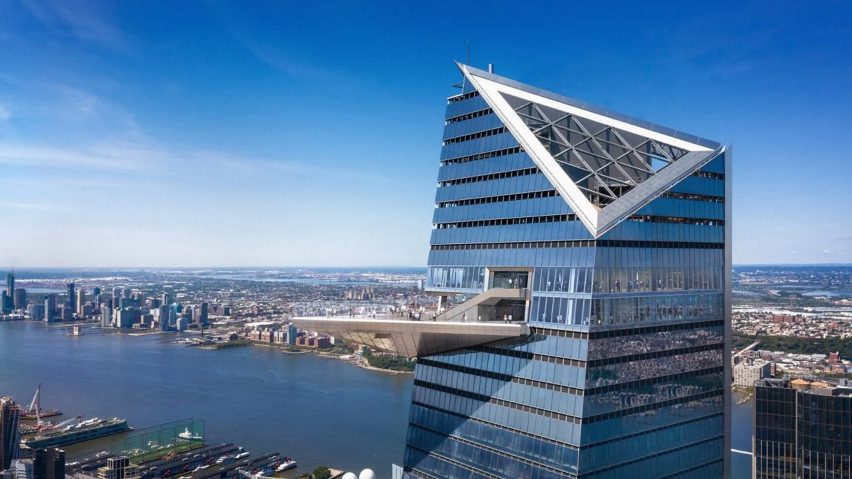Following last week's opening of the world's longest cantilever at One Za'abeel in Dubai, we've rounded up nine skyscrapers that are enlivened by dramatically suspended platforms, bridges and blocks.
Cantilevers are structural elements that typically extend horizontally from another volume and are only supported at one end, creating a striking gravity-defying visual effect.
Currently, the longest cantilever in the world measures 67.5 metres and projects out from between the two skyscrapers at One Za'abeel, a recently completed mixed-use development in Dubai. It narrowly takes the title from the observation deck at Marina Bay Sands in Singapore, which extends by 66.5 metres.
These two feats of engineering form part of our list, which spotlights nine skyscrapers – buildings over 150 metres in height – enlivened by precariously perched cantilevers.
Read on for the complete list:
One Za'abeel, United Arab Emirates, by Nikken Sekkei
The cantilever at One Za'abeel is the longest in the world, jutting out 67.5 metres above a six-lane highway in Dubai.
It forms a part of The Link, which is a 230-metre-long sky bridge boldly suspended between the two skyscrapers making up the development.
Japanese architecture studio Nikken Sekkei placed a glass floor at the end of the cantilever, enabling those who are brave enough to peer through its diagrid structure to the ground 100 metres below.
Find out more about One Za'abeel ›
Marina Bay Sands, Singapore, by Moshe Safdie
The title of the world's longest cantilever was previously held by the projecting observation deck at Marina Bay Sands in Singapore, designed by architect Moshe Safdie.
It is suspended from the end of the Sky Park, an elevated platform with a swimming pool that links the scheme's three towers.
In an interview with Dezeen, Safdie said that the deck evolved from a need to create space for a pool at the complex and that the final result put his American studio "on the map in Asia".
Find out more about Marina Bay Sands ›
Raffles City Chongqing, China, by Moshe Safdie
Another cantilever on the list by Safdie Architects is this glass-bottomed public viewing platform that forms part of the Raffles City Chongqing complex in China.
It extends from one end of The Crystal, a 300-metre-long sky bridge formed of glass and steel, which ties together four towers at the complex.
Throughout the rest of The Crystal is a mix of gardens, bars and restaurants, as well as a resident clubhouse and hotel lobby, all elevated 250 metres in the air.
Find out more about Raffles City Chongqing ›
De Rotterdam, the Netherlands, by OMA
The colossal De Rotterdam development by OMA in the Netherlands incorporates more than one cantilever in its blocky 150-metre-tall form.
According to OMA co-founder Rem Koolhaas, the overhangs are created by each volume being "slightly shifted vis-a-vis each other". This enables the individual blocks to be easily adapted while ensuring the building has a "very dynamic presence in the city", he said.
Find out more about De Rotterdam ›
CCTV Headquarters, China, by OMA
OMA linked two towers at the CCTV Headquarters in Beijing with a cranked bridge that has no end support, giving rise to a distinct silhouette that locals have nicknamed "big pants".
The building contains the headquarters for the state-owned China Central Television and was designed to challenge traditional skyscrapers that separate people across individual blocks, encouraging movement between them instead.
"An explicit ambition of the building was to try to hasten the end of the skyscraper as a typology, to explode its increasingly vacuous nature, loss of program, and refuse the futile competition for height," Koolhaas once said.
Find out more about CCTV Headquarters ›
This angular, suspended platform is the "highest outdoor sky deck" in the western hemisphere according to its architect, Kohn Pedersen Fox (KPF).
Named Edge, it juts out 24 metres from the 100th floor of 30 Hudson Yards in New York and has a glazed floor that frames views of the ground far below.
Find out more about 30 Hudson Yards ›
MahaNakhon, Thailand, by Büro Ole Scheeren
Another glass-floored cantilever is located at the top of Büro Ole Scheeren's 314-metre-tall MahaNakhon skyscraper, offering 360-degree views across Bangkok.
Called the Skytray, it is among several blocky cantilevered elements that appear to be precariously placed around the supertall structure, lending it a pixelated form.
Studio founder Ole Scheeren described the cantilevered elements as "living spaces that float high above the city", which invite occupants to "step out onto the terraces and transition to the open air".
Find out more about MahaNakhon ›
DJI Sky City, China, by Foster + Partners
Glass volumes encased by steel trusses are stacked and cantilevered at varying heights around DJI Sky City, the home of robotics company DJI in Shenzhen.
Designed by Foster + Partners, the suspended blocks are supported by vertically slatted cores and contain column-free office spaces, thanks to their external trusses. At the top of each cantilevered volume is a rooftop garden, affording views across the city.
In addition to the cantilevers, the studio connected the two towers with an open-air suspension bridge 100 metres above the ground.
Find out more about DJI Sky City ›
56 Leonard Street, USA, by Herzog & de Meuron
A series of cantilevered elements that become increasingly offset from one another create a staggered form for this residential skyscraper in New York. It was designed by Herzog & de Meuron to challenge conventional high-rise architecture.
"To break-up the tendency towards repetition and anonymity in high-rise buildings, 56 Leonard Street was developed from the inside out," said the studio.
"The overall appearance of the tower is very much a result of accepting and pushing to the limit simple and familiar local methods of construction."
Find out more about 56 Leonard Street ›

